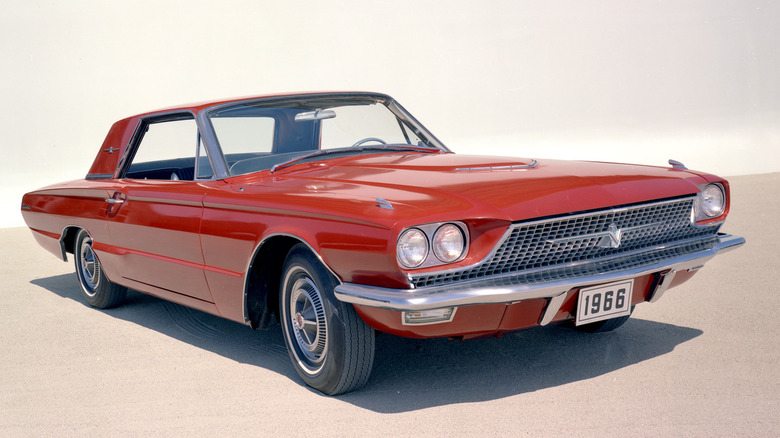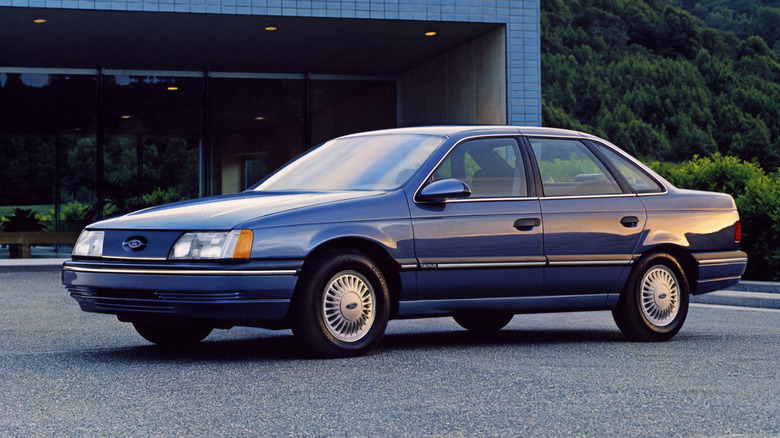5 Cars Ford Should Have Never Discontinued
Few automotive names are as recognizable as Ford. Henry Ford is generally credited with bringing cars to the masses through his eponymous motor company, launching the Model T at a price average people could afford, and building it in sufficient numbers to get everyone who wanted one behind the wheel. But Ford's legacy isn't limited to that first mass-produced car.
Ford has produced many iconic cars in its century-plus history, but not all of them are still around. Whether it's changing customer tastes, different business priorities, or Ford's more recent effort to slim down the number of nameplates it offers to cut costs, many of the most fondly remembered Ford models exist only in the form of a handful of collector cars and the occasional trademark renewal. But it's fun to speculate about what could be.
Ford takes its heritage seriously. It's grown the Bronco and Mustang from single models to sub-brands, with multiple models wearing those famous nameplates. Instead of doing yet another Bronco or Mustang variant, Ford should consider bringing one of these cars from its past back into production.
Thunderbird
The Ford Thunderbird underwent many incarnations during 42 years of continuous production and a brief revival in the early 2000s. The T-Bird launched in 1955 as a pure sports car, going head-to-head with the Chevrolet Corvette. It even had the upper hand in sales at first, worrying General Motors executives.
Ford soon took the Thunderbird in a different direction, making the Thunderbird larger and more luxurious. Originally a two-seater, the Thunderbird gained a second pair of seats with a 1958-model-year redesign and remained a four-seater from then on. Through the 1960s and 1970s, the bigger 'Birds went further away from the original Thunderbird's sporty origins, with baroque styling and minimal performance credentials.
That changed in the 1980s when Ford introduced a new Thunderbird that was still fairly large (to help distinguish it from the Mustang with which it shared an increasing number of components) but also aerodynamic. This made it ideal for NASCAR, which at the time still required race cars to have the same silhouette as production models. The Thunderbird represented Ford in NASCAR until 1997 when production of T-Bird road cars ended. Ford briefly revived the Thunderbird with retro styling, but that final generation only lasted from 2002 to 2005.
Given its legacy of changing with the times, surely Ford could find a new use for the Thunderbird name today?
Fiesta
Ford built the last Fiesta for the European market in June 2023, having withdrawn this subcompact car from the United States market several years before. That ended a production run that stretched back to 1976.
That longevity shows the importance of small, basic cars. The Fiesta started out as a way for drivers to beat the high gas prices of the 1970s, and despite the first-generation model's lack of style and underwhelming performance, it stuck around. Sometimes people just need affordable transportation.
The Fiesta also had plenty of potential. Its small size, augmented by more power, made for entertaining performance models in the form of the ZR2 and, later, the ST. The final European-market Ford Fiesta ST extracted 197 horsepower from a turbocharged 1.5-liter three-cylinder engine and did zero to 62 mph in a respectable 6.7 seconds.
Whether it's affordability and fuel efficiency or nimble handling and sprightly acceleration, small cars like the Fiesta have a lot to offer. It's too bad Ford—and the rest of the auto industry—is moving in a different direction.
Taurus
The Taurus was never Ford's most exciting model, but it proved the venerable automaker could keep up with changing trends in the auto industry.
The first incarnation of this midsize sedan launched for the 1986 model year to challenge the likes of the Honda Accord and Toyota Camry. Ford and other American automakers had been losing sales to the Japanese brands, which brought more efficient front-wheel drive vehicle architectures and better build quality to the table. Ford checked both boxes with the first-generation Taurus and added distinctive styling that's now delightfully retro.
Ford couldn't maintain its momentum, though. Later redesigns introduced questionable oval-themed styling, and build quality and reliability eventually reverted to American norms. Even the occasional Taurus SHO (short for "Super-High Output") performance model couldn't help.
The Taurus was always fighting a losing battle against more profitable SUVs and pickup trucks, which have pushed all cars except the Mustang out of Ford's U.S. lineup. Regular cars still have some advantages, though, including lower weight and aerodynamic drag that can help boost range in EVs. The Taurus name is also still recognizable, so it would be perfect for a Ford sedan revival.
Explorer Sport Trac
Today, Ford is all about trucks. The F-150 is its bestseller, and it's flanked by a full lineup of pickups, including the compact Maverick, midsize Ranger, and heavy-duty Super Duty. Ford once had another, very different, pickup in its lineup, though.
Debuting in 2000, the Ford Explorer Sport Trac was a pickup version of the popular Explorer midsize SUV. Ford stretched the wheelbase to accommodate a pickup bed but kept the standard Explorer cabin. This meant the Sport Trac had less bed space than contemporary pickups but a greater level of refinement. Ford redesigned the Sport Trac for the 2007 model year but discontinued it after the 2010 model year.
Ford was on to something, though. Today's Honda Ridgeline is based on a similar formula. It uses the platform of a midsize SUV (it's based on the Honda Pilot) to deliver a more pleasant driving experience than conventional pickups. Ford could probably do the same with the current Explorer, potentially building on the Europe-only EV version.
Falcon
The Falcon was Ford's original compact car. The signature achievement of Robert McNamara before he left Ford to become secretary of defense in the Kennedy administration, the Falcon launched in 1960 as a smaller, simpler car that countered the automotive decadence of the late 1950s.
Ford later used the Falcon as the basis for the Mustang, but the pioneering compact car soon fell out of relevance in the U.S. Ford's Australian division continued to apply the Falcon name to larger cars, though, which became classics down under. An XB Falcon was the basis for the "Mad Max" V8 Interceptor. Australian car enthusiasts adored the Falcon in the same way American enthusiasts adored the Mustang.
The Australian Falcon also retained the classic muscle-car combination of a V8 engine and rear-wheel drive to the end. Cars like this are quickly disappearing, but if they were to make a comeback, the Falcon should be among them. If nothing else, its name resonates in both Australia and America.





